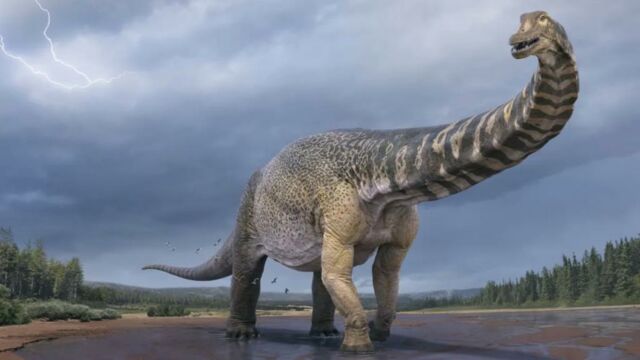Meet Australotitan, the largest dinosaur ever unearthed in Australia

Scientists unearthed a new gigantic sauropod. Named Australotitan cooperensis, the 30-metre long dinosaur is likely the largest ever identified.
A dinosaur as long as a basketball court and as tall as a double-decker bus. Scientists in Australia have discovered a real titan. In a study published by the journal PeerJ, a team has just announced the discovery of a new species of sauropod. And what a species.
Discover our latest podcast
According to the analysis of its fossils, the animal could reach a height of 5 to 6.5 metres and a length of 25 to 30 metres. These colossal measurements place it directly among the largest dinosaurs ever identified and allow it to claim the title of the largest dinosaur ever discovered in Australia.
More under this adMore under this adMore than ten years of research
The species belongs to the titanosaur family, which already includes several of the largest known creatures, but it is the first of a new genus. It has been named Australotitan cooperensis after the place where its skeleton appeared: in the Cooper Creek region of southwest Queensland.

The fossils were first found near Eromanga in 2007. But it took more than a decade of research to learn more about its former owner, to reconstruct the skeleton and compare it to other sauropods already identified in Australia and elsewhere. Queensland Museum palaeontologist Scott Hocknull, the report's first author, said in a statement:
To be sure Australotitan was a different species, we had to compare its bones to those of other species in Queensland and around the world. This was a laborious and time-consuming task.More under this adMore under this ad
The reason why the task proved so arduous was because the bones being studied are huge, very heavy, fragile and are kept in different institutions, sometimes hundreds or even thousands of kilometres away. To conduct their study, Dr. Hocknull and his colleagues decided to use digital technology.
Tons of bones in a laptop
They scanned all the Australotitan fossils in all three dimensions to compare them with those of its closest cousins.
The 3D scans we created allowed me to carry thousands of kilos of dinosaur bones in a 7 kg laptop.More under this adMore under this ad

Analysis indicated that the giant creature was closely related to three other Australian sauropods that lived during the Cretaceous period some 92 to 96 million years ago: Diamantinasaurus matildae, Wintonotitan wattsi and Savannasaurus elliottorum.
More under this adMore under this adIt seems the big Australian dinosaurs were all part of one big happy family.
But with its gigantic size and an estimated mass of between 50 and 70 tonnes, Australotitan would take the title of the largest of the family.
More under this adMore under this adThis new discovery confirms the presence of huge sauropods during the Cretaceous period, when Australia was still part of the supercontinent Gondwana. However, information on the fauna of the time is still far from complete.
Predators remain to be found
Scientists believe that other such imposing creatures have yet to be discovered. Dr Hocknull told the Sydney Morning Herald:
More under this adMore under this adIn other parts of the world where we've found these huge herbivorous dinosaurs, we've also found huge theropod dinosaurs hunting them.
A few species of theropods have already been unearthed from the Winton area, but at five to six metres long, they would have posed very little threat to the Australotitan.
More under this adMore under this adThis suggests that somewhere out there is a very large predatory dinosaur. We just haven't found it yet.

A. cooperensis represents the first find in this region of southwest Queensland. As palaeontologists continue to excavate across the state, they hope to unearth new treasures to shed light on the past of this part of the island continent. Dr Jim Thompson, chief executive of the Queensland Museum Network, declared in the statement:
Australia is one of the last frontiers for dinosaur discovery and Queensland is fast becoming the paleo-capital of the nation - there's still plenty to discover.More under this adMore under this ad
A life-size reconstruction of the Australotitan and its fossils are on display in a special wing of the Eromanga Natural History Museum, which was founded by a team from the Queensland Museum and local palaeontologists.